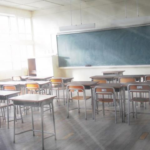I'm Shinnosuke Iguchi, contrabass player, brass band instructor, and conductor.
Since 2017, with the theme of wishing for the understanding and development of the contrabass in brass band, "Lesson notes for tomorrow" for junior high and high school students who play the contrabass in music club activities such as brass band clubs nationwide. I wrote a lesson blog titled.
Many of the messages that reach my SNS are
only one party
There's no one around to teach you how to play the contrabass
From junior high school students who are doing music activities in the area.
There is an audition for a brass band competition, but no one has taught it, only a part-time instructor for the contrabass has not come, and an external instructor has pointed out things such as not understanding.
Lesson notes were born while listening to concerns and consultations received from junior high and high school students all over the country.
By writing down every week what I need to know in order to play the double bass in the brass band club, I have continued to strive to develop the contrabass in music-related club activities, including brass band clubs nationwide.
So far, I have continued to write while updating in 2017, 2018, and 2020.
There were times when I was too busy and there were times when I couldn't make progress at all, so I quit halfway through twice, but I'm going to write again this year with a new feeling.
This year, I had the opportunity to give a lesson to an international student from overseas. While I was giving a lecture in Japanese, I remembered how hard they listened to me, and this time I decided to write lesson notes in their native language.
I can't speak English, so I'm writing this using Google Translate.
It may be a strange sentence, but I would be happy if the message was conveyed in the hints for practice.
In the lesson notes, we will write what we are actually teaching in the lesson.
The lesson notes for tomorrow (hereafter referred to as lesson notes) are written step-by-step about what I have been teaching during my lessons for music club activities, students taking exams, and amateur players. To go.
There is a limit to what can be conveyed through text alone, so I will omit the parts that would cause confusion if explained only with words. I would like to write what I can convey based on the experience of giving me.
I think that you can practice while referring to the contrabass instruction book that many people have been using as a practice partner, as well as the "Lesson Notes for Tomorrow" that I have made available free of charge. increase.
Let's practice together little by little.
I'm sure there are people who play the contrabass in brass bands, orchestras, string ensembles, mandolins, amateur orchestras, brass bands, and many other places.
Now! So much for the introduction, "Lesson notes for tomorrow" 2022 starts!
Before practice, check the condition of the instrument!
Before starting a lesson, first check the condition of the instrument.
In particular, the condition of the instrument that has been used for many years in club activities is often difficult to play, so please take this opportunity to check the condition of the instrument you are playing.
One hour is enough to check the condition of the instrument.
Ease of playing can be changed simply by adjusting or replacing strings, bridges, and endpins.
Stringed instruments can cost a lot of money to repair, so if there is a problem with the condition of the instrument, repairing even the bare minimum of undercarriage (strings, bridges, and endpins) will make a big difference in how easy it is to play.
Checking the condition of the instruments is something that I always do in the brass band and orchestra clubs when I go to lessons for the first time.
Are there any "cracks" or "peeling" on the instrument?
Since stringed instruments are made of wood, they are greatly affected by humidity.
It is a good idea to check once to see if the board of the instrument is cracked or if the sides are peeled off.
In particular, I have the impression that many of the problems that occurred with instruments stored in humid corridors or preparation rooms without air-conditioning equipment were that the joints were peeling off.
Are the endpins adjustable?
When playing the contrabass, a pin called an end pin, whose length can be adjusted, is adjusted according to the player's height.
Instruments that cannot be adjusted due to damaged endpin screws
pin is bent
The screws are tight and cannot be adjusted.
In such cases, repair is required.
The Picture is the state that the socket part of the end pin of the contrabass that I saw in the lesson in the past and took out from the preparation room for the first time in a few years was damaged and broken.
In such cases, the socket should be replaced.
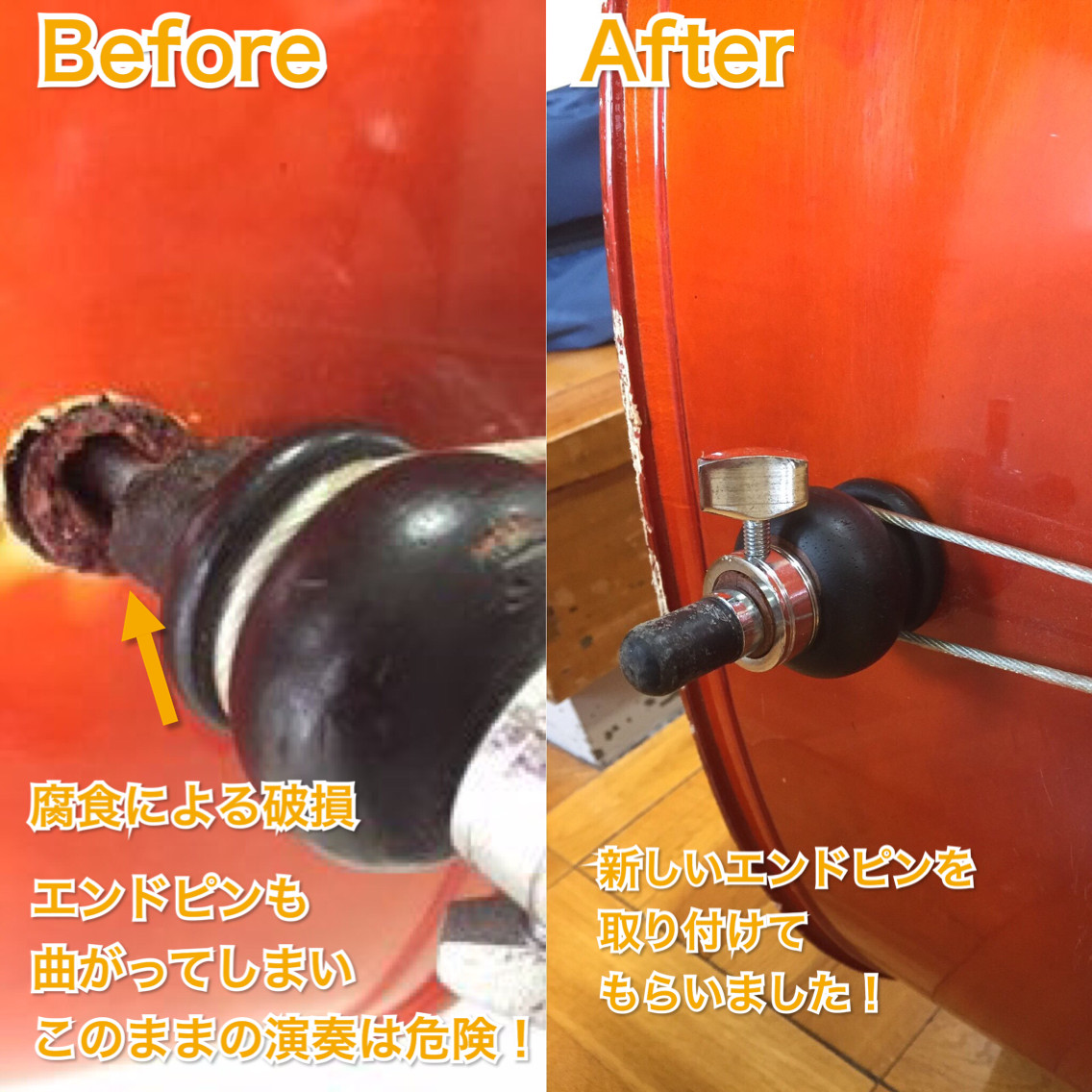
Do you have end rubber?
I have been asked before, "Is it better to remove the endpin rubber?"
Also, an outside lecturer told me that the sound would be better if the endpin rubber was removed, and I once saw him playing the instrument with the endpin rubber removed.
It is true that removing the endpin rubber can make the sound richer, but in some cases it is attached as a non-slip rubber, so first you need to know what type of endpin your instrument has. It is important to keep
There are two main types of double bass endpins, and the one that can be played without the rubber is "only the type with a sharp tip that can be played by sticking it directly into the floor."
If you look closely, you can see that the ends of the endpins in this photo are rounded.

If you remove the non-slip rubber from the rounded end pin, the instrument may slip during playing, which is very dangerous, so keep that in mind.
If there is a hole in the rubber of the endpin or if the rubber is not attached, it is often sold at a nearby music store, so please look for it.
"When did you replace the strings?" Here are the points I checked at least!
Contrabass strings are expensive but consumables.
One thing I often hear about in brass band clubs is that when a string breaks, it needs to be replaced.
It is said that it is ideal to replace the strings of a contrabass every one to two years.
Strings, which are consumables, can be injured depending on their condition, so here are some points that you should check.
Are there any hangnails or bullion visible?
Check to see if the part that holds the strings is in the condition shown in the picture.
Place your hand on the fingerboard and try to stroke the strings from top to bottom.
Does it feel rough and is there anything that catches your hand?
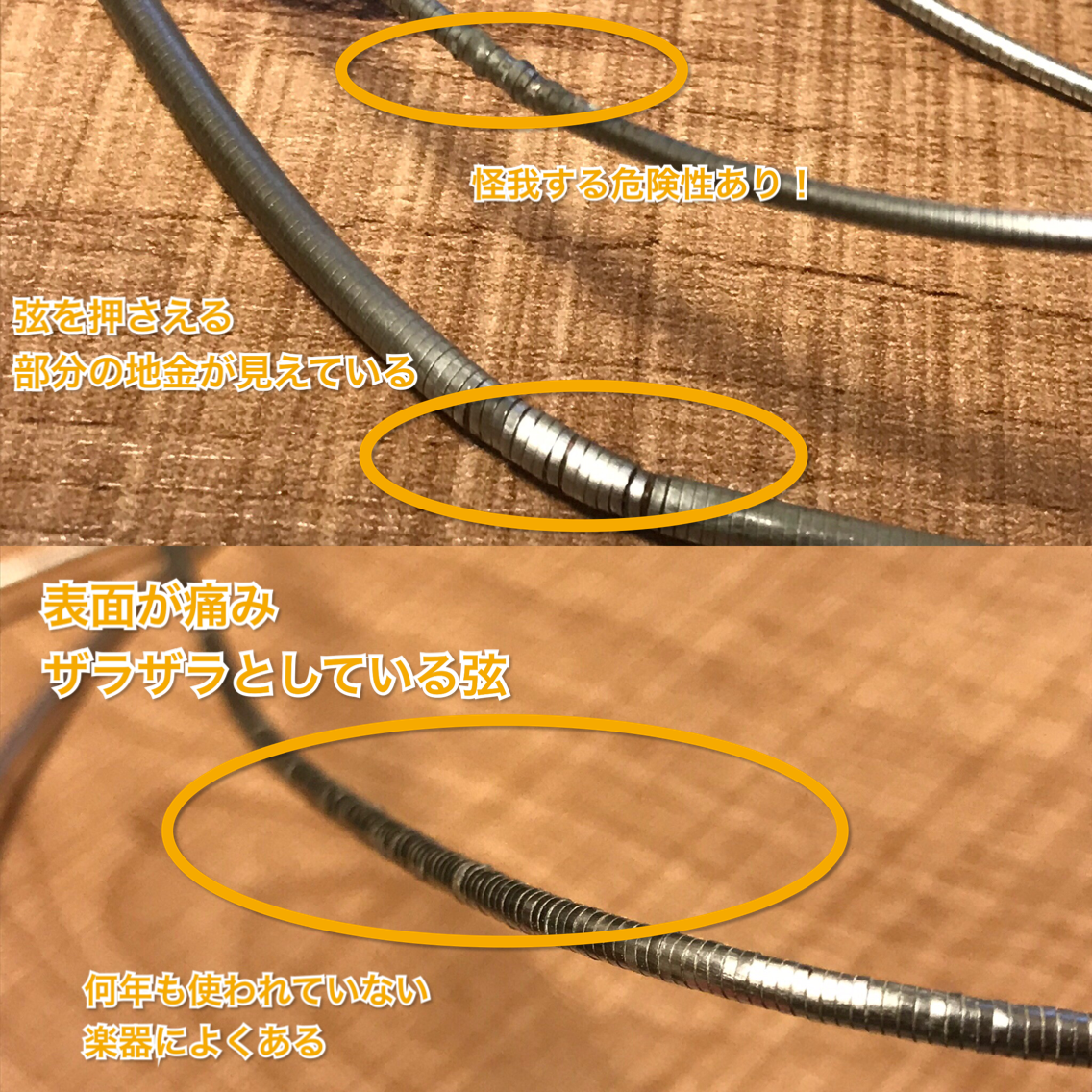
If this is the case, it might be a good idea to replace the strings.
I can't give you specific advice without actually seeing it, but if you feel a tingling sensation on the string or if you feel a tingling sensation on the string, you may injure yourself. It would be a good idea to ask your teacher if it is possible to exchange the swords.
You can do it now! Check the condition of the pieces
Finally, check the condition of the pieces.
It is difficult to hold down the strings
The pitch is not fixed,
the finger holding it hurts
I felt that if the cause of such troubles was the instrument, there was often a problem with the condition of the bridge.
Is the string height too high?
What is string height?
String height is the gap between the fingerboard and the strings.
There is no rule that the string height must be ◯◯, but the string height greatly affects the ease of playing the instrument.
The guideline found in many textbooks is
G line 10mm, D line 12mm, A line 14mm, E line around 15mm
Place a ruler over the cut in the fretboard and measure the distance to each string.
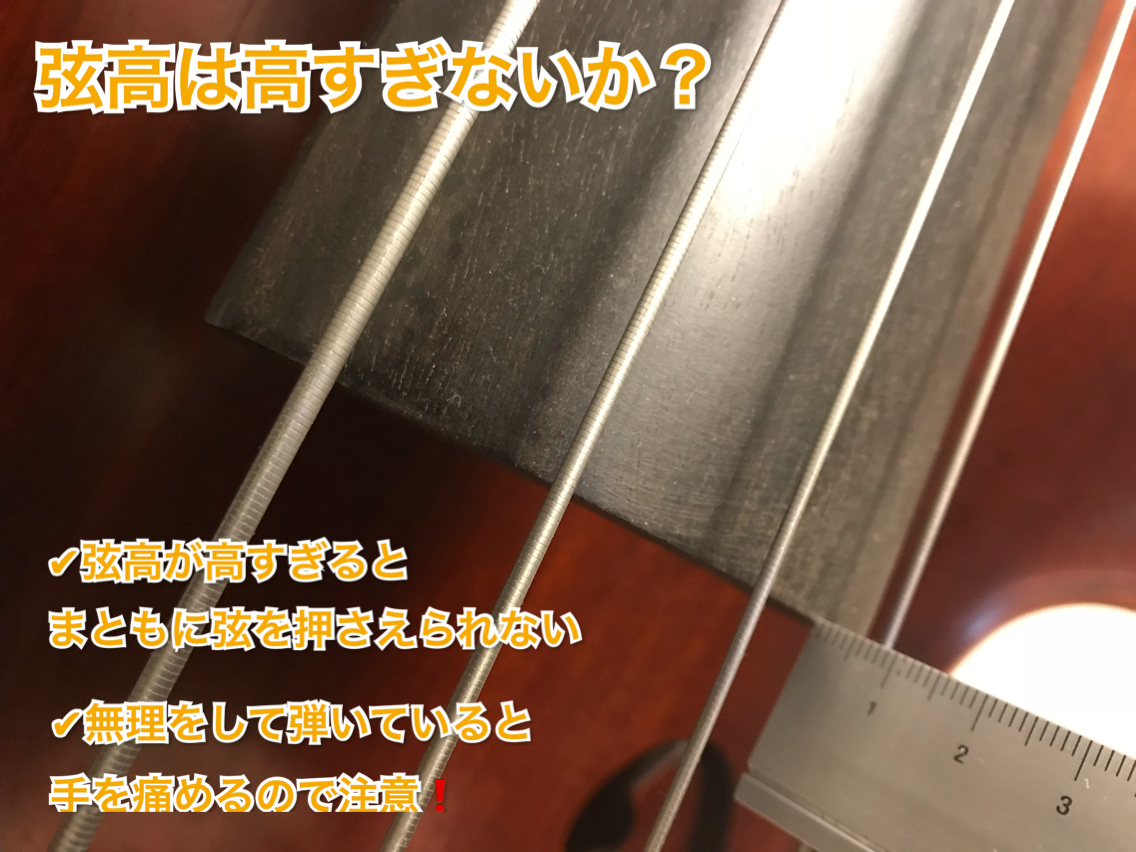
Are the pieces not warped, and are the pieces standing straight with no gaps between their legs?
You also want to check if the pieces are bent upwards or if the legs of the pieces are standing straight.
Since the bridge is only supported by the tension of the strings, it often happens that the bridge, which was standing straight, moves left and right when the instrument hits it.
A bad example is a piece that has been soiled with pine resin dust.
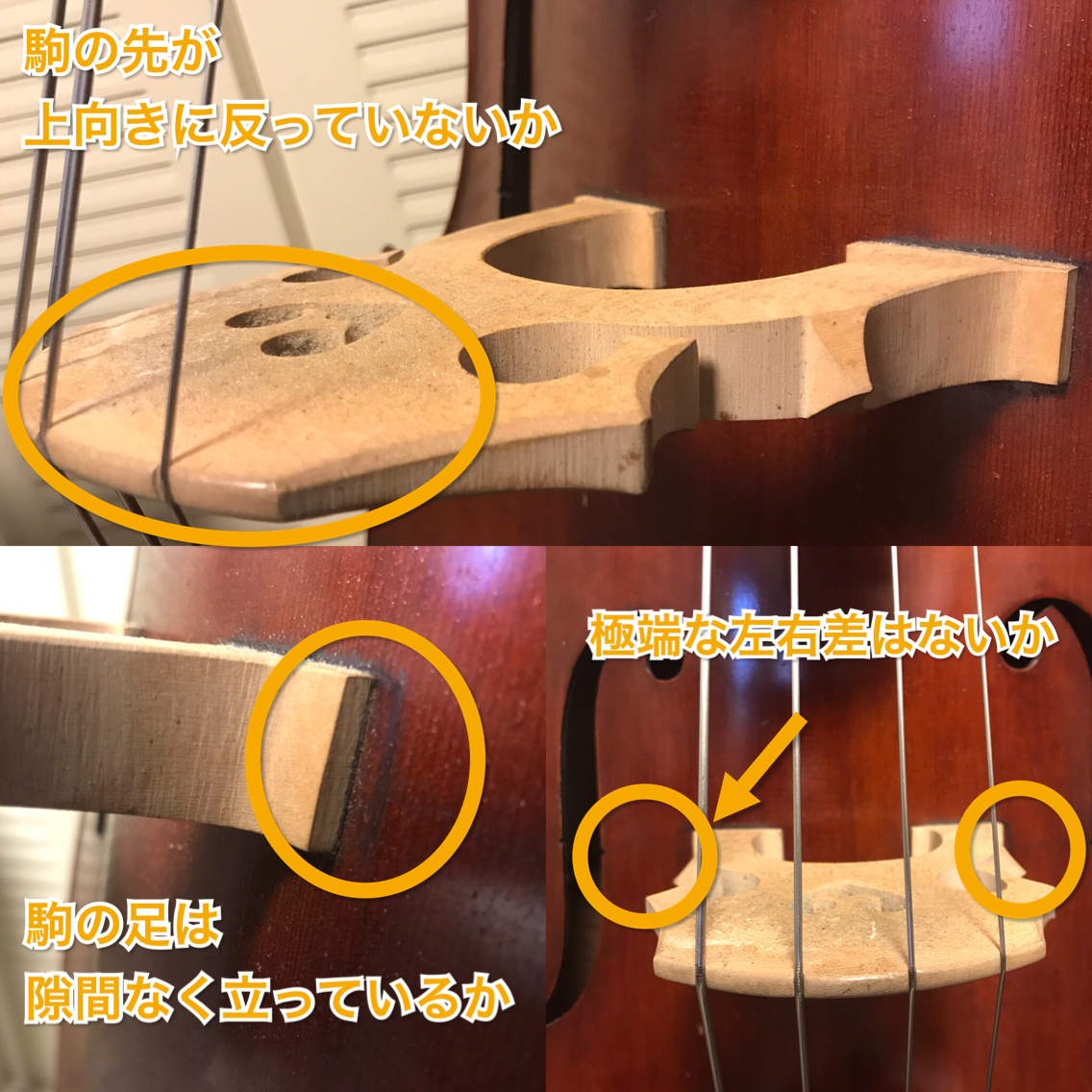
Let's be careful! Be careful when handling pieces
As I wrote earlier, the bridge is supported by the tension of the strings.
Therefore, if you think that the bridge is out of alignment and try to loosen the strings and try to put it back in place, there is a danger that the sound post inside the instrument will fall over.
If the piece is misaligned, we recommend that you consult a musical instrument shop through your advisor. When I go to a lesson, I sometimes fix a little misalignment, but if I feel that there is a problem with a piece, I report it to my advisor teacher and ask for repair or adjustment.
The above points are the parts you want to check in the state of the instrument.
Summary of this time
I started by checking the condition of the instrument I was playing.
What was your instrument like?
This time, I have written an excerpt of the places I want to check in each part, but I want to know more! For those who say, please use the contrabass instruction book "Lesson Note for Tomorrow", which is open to the public for free on all pages.
This is the end of the lesson notes.
From next time, let's make more sounds!
Contrabass lessons, questions and consultations are always welcome
Questions, questions and consultations that arise while reading the lesson notes for tomorrow are answered on my SNS accounts or on the LINE official account "Contrabass Laboratory BASSROOM".
So far, I have answered questions from more than 100 junior high and high school students and amateur musicians.
📌公式LINEのお知らせ
コントラバス奏者・吹奏楽指導者、井口信之輔の公式LINE『BASS ROOM』を開設しています。個人で受けられる質問、レッスン、演奏会情報を不定期に配信していきます。
友だち登録方法👫
・ @tai3026a ←@を含めてID検索🔎
・ QRコードから友だち追加
よろしくどうぞ〜❗️ pic.twitter.com/qCsIRFrB0w— 井口信之輔|コントラバス𝕏吹奏楽指導 (@igu_shin) January 26, 2018
Bonus: About the Author What kind of person is Shinnosuke Iguchi?
First, let me introduce the author.
I met the double bass in the orchestra club of Katsushika Junior High School in Funabashi, joined the brass band at Ichikawa Nishi (Ichikawa Subaru) High School in Chiba Prefecture, and studied the double bass at Senzoku Gakuen College of Music.
I have had a stutter since I was a child, and when I was speaking in formal situations, I was unable to come up with words.
Originally, he went to a music college with the aim of becoming a professional orchestra player and practiced hard, but when he played an instrument in front of people, he suffered from extreme anxiety, and at that time his mental state was such that he stuttered and could not speak. I feel that time is the same, I think this is going to be a long game, where is the place where I can make use of myself? I'm going to look for it.
I became interested in wind instrument instruction after listening to the 21st regular concert of the Chiba Prefectural Ichikawa Nishi High School Brass Band Club held in 2008.
When I listened to Kyoji Yagisawa's performance of "Nasca" - a distant galaxy drawn on the ground, I thought, "I want to teach a band, too!"
In 2016, I started posting on SNS in earnest, and in response to consultations from junior high and high school students who play the double bass in brass band clubs nationwide, I started posting information on my blog that I needed to know in order to play the double bass in the brass band club. Repeating the cycle of outputting what I input as a leader, I have reached the present.
Recent teaching achievements
My main teaching achievements are listed in my profile, but here I will introduce my recent teaching achievements.
Guidance school
This year, there are about 33 junior high and high school groups, ranging from brass band clubs to string ensembles and orchestra clubs.
I was involved in teaching local schools mainly in the Kanto area (Tokyo, Kanagawa, Saitama, Chiba) through online lessons. We provide a wide range of instruction, from contrabass lessons to ensemble instruction.
Also, starting this year, I have been supporting brass band clubs at public junior high schools in the Kanto area as a club activities instructor.
conductor, trainer
Yokohama Monday Band (Conductor)
Orchestra pìccolo for beginners and children (conductor/trainer)
Symphonic Ensemble Bouquet (String Trainer)
Armonioso Concerto (Trainer)
Aururi String Ensemble (Trainer)
Hirayama Conservatory Orchestra (2019 String Orchestra, 2021 Conducting and teaching children's string ensemble)
Ichikawa Windarchestra 5th Concert (Conductor)
Award/pass record
1st Contrabass Solo Contest for Junior High and High School Students
Junior High School Category: Gold Award High School Category: Gold Award, Silver Award
2nd Contrabass Solo Contest for Junior High and High School Students
Junior High School Category: Gold Award, Silver Award High School Category: Gold Award
2020: 1 student passed high school music course
Even after retiring from club activities, I often keep in touch with the students I met in lessons, and one of the things I look forward to is seeing how they go on to higher education or get a job and are active in their respective places.
We are rooting for you to reach your dreams and goals!
His favorite food is standing eating soba, his hobbies are fishing, driving, and the Odakyu Line.
I am currently studying psychology.
I tried to write it briefly, but he is such a person.

